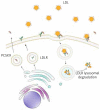The role of proprotein convertase subtilisin/kexin type 9 (PCSK9) in the pathophysiology of psoriasis and systemic lupus erythematosus
- PMID: 36090718
- PMCID: PMC9454343
- DOI: 10.5114/ada.2022.118919
The role of proprotein convertase subtilisin/kexin type 9 (PCSK9) in the pathophysiology of psoriasis and systemic lupus erythematosus
Abstract
Inflammation and atherogenic dyslipidaemia are often observed in skin diseases and represent an increased risk of cardiovascular disorders. Proprotein convertase subtilisin/kexin type 9 plays an important role in the regulation of serum low-density lipoprotein cholesterol levels. Its biological role, however, seems to go much beyond the regulation of cholesterol metabolism. The article presents potential pathophysiological links between inflammatory process and lipid disorders based on the example of psoriasis and systemic lupus erythematosus.
Keywords: PCSK9; alirocumab; evolocumab; psoriasis; systemic lupus erythematosus.
Copyright: © 2022 Termedia Sp. z o. o.
Conflict of interest statement
The authors declare no conflict of interest.
Figures


References
-
- Abifadel M, Guerin M, Benjannet S, et al. . Identification and characterization of new gain-of-function mutations in the PCSK9 gene responsible for autosomal dominant hypercholesterolemia. Atherosclerosis 2012; 223: 394-400. - PubMed
-
- Cohen J, Pertsemlidis A, Kotowski I, et al. . Low LDL cholesterol in individuals of African descent resulting from frequent nonsense mutations in PCSK9. Nat Genet 2005; 37: 161-5. - PubMed
-
- Artenstein A, Opal S. Proprotein convertases in helath and disease. N Engl J Med 2011; 365: 2507-18. - PubMed
-
- Siedah N. The proprotein convertases, 20 years later. Methods Mol Biol 2011; 768: 23-57. - PubMed
Publication types
LinkOut - more resources
Full Text Sources
Miscellaneous
